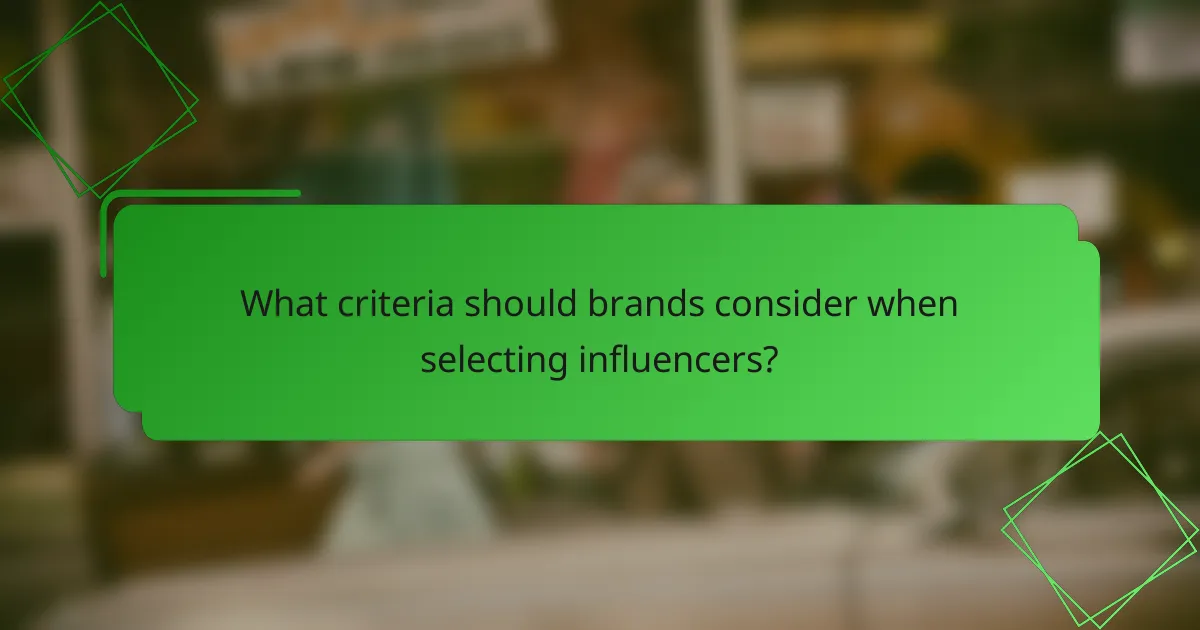Influencer partnerships are a powerful strategy for brands looking to expand their reach and enhance credibility. By collaborating with trusted figures who have established audiences, brands can tap into new demographics and foster deeper connections with potential customers. These partnerships not only boost visibility but also drive engagement through authentic endorsements and meaningful interactions.

How can influencer partnerships enhance brand reach?
Influencer partnerships can significantly enhance brand reach by leveraging the established audiences of influencers. By collaborating with individuals who have a strong following, brands can tap into new demographics and increase their visibility in the market.
Increased audience exposure
Partnering with influencers allows brands to gain exposure to a broader audience. Influencers often have dedicated followers who trust their recommendations, making it easier for brands to reach potential customers who may not be familiar with them. This exposure can lead to higher brand awareness and recognition.
To maximize audience exposure, brands should choose influencers whose values align with their own. This alignment ensures that the message resonates with the influencer’s audience, increasing the likelihood of engagement.
Access to niche markets
Influencer partnerships provide brands with access to niche markets that may be difficult to penetrate through traditional marketing channels. Influencers often cater to specific interests or demographics, allowing brands to target their products or services more effectively.
For example, a skincare brand could collaborate with a beauty influencer who specializes in organic products, reaching consumers who prioritize natural ingredients. This targeted approach can result in higher conversion rates and customer loyalty.
Boosted social media visibility
Influencers can significantly boost a brand’s visibility on social media platforms. When influencers share content featuring a brand, it often leads to increased engagement, such as likes, shares, and comments, which can amplify the brand’s reach.
Brands should encourage influencers to create authentic content that showcases their products in a relatable way. This authenticity fosters trust and encourages followers to engage with the brand’s social media profiles.
Enhanced content sharing
Influencer partnerships can lead to enhanced content sharing across various platforms. When influencers create compelling content, their followers are more likely to share it with their networks, further expanding the brand’s reach.
To facilitate sharing, brands should provide influencers with high-quality visuals and clear messaging. This makes it easier for influencers to create shareable content that resonates with their audience.
Improved SEO through backlinks
Collaborating with influencers can improve a brand’s search engine optimization (SEO) through backlinks. When influencers link to a brand’s website in their content, it can enhance the brand’s online authority and visibility in search results.
Brands should focus on building relationships with influencers who have reputable websites or blogs. This strategy not only drives traffic but also strengthens the brand’s credibility in the eyes of search engines.

What credibility do influencers bring to brands?
Influencers enhance brand credibility by leveraging their established trust with followers, authentic endorsements, niche expertise, and long-term relationships. This credibility can significantly impact consumer perceptions and purchasing decisions.
Established trust with followers
Influencers often cultivate a loyal audience that values their opinions and recommendations. This trust translates into a higher likelihood that followers will consider and engage with brands endorsed by the influencer. Brands can benefit from this established trust, as it often leads to increased brand loyalty and customer retention.
To maximize this trust, brands should choose influencers whose values align with their own. A mismatch can lead to skepticism among followers, undermining the partnership’s effectiveness.
Authentic endorsements
Authenticity is key in influencer marketing. When influencers genuinely believe in a product or service, their endorsements resonate more with their audience. This authenticity can drive higher engagement rates and conversions compared to traditional advertising methods.
Brands should encourage influencers to share personal experiences with their products. This approach not only enhances credibility but also creates relatable content that followers are more likely to share.
Expertise in specific niches
Many influencers specialize in particular niches, such as beauty, fitness, or technology. Their expertise allows them to provide informed opinions, making their endorsements more credible. Brands can leverage this niche knowledge to reach targeted audiences effectively.
When selecting influencers, brands should consider those who have a proven track record in their specific industry. This ensures that the influencer’s audience is genuinely interested in the products being promoted.
Long-term relationship building
Building long-term relationships with influencers can enhance brand credibility over time. Consistent partnerships allow influencers to become more familiar with a brand, leading to more authentic and informed endorsements. This familiarity can foster deeper connections with their audience.
Brands should aim for ongoing collaborations rather than one-off campaigns. This strategy not only strengthens the influencer’s association with the brand but also helps in cultivating a loyal customer base that trusts the influencer’s recommendations.

How do influencer partnerships drive engagement?
Influencer partnerships drive engagement by leveraging the influencer’s established audience and credibility to foster deeper connections with potential customers. These collaborations can significantly enhance interaction rates, encourage user-generated content, and provide valuable real-time feedback.
Higher interaction rates
Influencer partnerships typically result in higher interaction rates compared to traditional marketing methods. Influencers often have loyal followers who trust their recommendations, leading to increased likes, shares, and comments on promotional content. Brands can expect interaction rates that are often several times higher than standard social media posts.
To maximize these rates, brands should choose influencers whose audience aligns closely with their target market. Engaging content, such as giveaways or polls, can further enhance interaction by prompting followers to participate actively.
Encouraged user-generated content
Influencer partnerships can stimulate user-generated content (UGC), where followers create and share their own content related to the brand. This organic promotion not only increases brand visibility but also builds community and trust among consumers. Brands can encourage UGC by creating specific hashtags or challenges for followers to engage with.
For example, a beauty brand might collaborate with an influencer to launch a makeup challenge, prompting followers to share their looks using a designated hashtag. This approach can lead to a wealth of authentic content that showcases the brand in a relatable context.
Real-time feedback and insights
Collaborating with influencers allows brands to receive real-time feedback and insights about their products or campaigns. Influencers can gauge audience reactions and provide immediate responses, helping brands adjust their strategies quickly. This feedback loop is invaluable for refining marketing efforts and enhancing product offerings.
Brands should actively monitor engagement metrics and comments on influencer posts to gather insights. Utilizing tools for social listening can help track sentiment and identify trends, enabling brands to respond proactively to consumer needs and preferences.

What criteria should brands consider when selecting influencers?
Brands should consider several key criteria when selecting influencers, including audience alignment, engagement metrics, content quality, and compatibility with brand values. These factors help ensure that the partnership is effective and resonates with the target market.
Audience alignment
Audience alignment refers to the match between the influencer’s followers and the brand’s target audience. Brands should analyze demographics such as age, gender, location, and interests to ensure that the influencer’s audience reflects their ideal customer profile.
For example, a beauty brand targeting young women should partner with influencers whose followers predominantly consist of that demographic. Tools like social media analytics can help brands assess audience characteristics effectively.
Engagement metrics
Engagement metrics indicate how actively an influencer’s audience interacts with their content. Key metrics include likes, comments, shares, and overall engagement rates, which can vary widely across different platforms.
Brands should look for influencers with high engagement rates, typically in the range of 1% to 5% for Instagram. This suggests that the influencer’s audience is not only present but also actively interested in their content, making them more likely to respond positively to brand promotions.
Content quality
Content quality encompasses the style, creativity, and professionalism of an influencer’s posts. Brands should evaluate the aesthetic appeal, originality, and relevance of the content to ensure it aligns with their own brand image.
For instance, a luxury brand may prefer influencers who produce high-quality, polished content, while a more casual brand might opt for influencers with a relatable and authentic style. Reviewing past collaborations can provide insights into an influencer’s content quality.
Brand values compatibility
Brand values compatibility is crucial for maintaining authenticity and trust with consumers. Brands should assess whether an influencer’s personal values, beliefs, and messaging align with their own brand ethos.
For example, a sustainable fashion brand should collaborate with influencers who advocate for eco-friendly practices. Misalignment can lead to backlash and damage to both the brand’s and the influencer’s reputation, so thorough vetting is essential.

How can brands measure the success of influencer partnerships?
Brands can measure the success of influencer partnerships through various metrics that reflect their effectiveness in reaching target audiences and driving engagement. Key indicators include conversion rates, engagement statistics, and overall brand sentiment.
Tracking conversion rates
Tracking conversion rates helps brands understand how many users take a desired action after engaging with an influencer’s content. This could include making a purchase, signing up for a newsletter, or downloading an app. Brands should implement unique tracking links or promo codes to accurately measure these conversions.
For example, if an influencer promotes a product with a specific discount code, brands can easily assess how many sales resulted from that promotion. A conversion rate of 2-5% is generally considered effective in influencer marketing.
Analyzing engagement statistics
Engagement statistics provide insights into how audiences interact with influencer content. Metrics such as likes, shares, comments, and overall reach are crucial for evaluating the effectiveness of a partnership. High engagement rates often indicate that the content resonates well with the audience.
Brands should aim for engagement rates of around 1-3% for posts, depending on the platform. Monitoring these metrics over time can help identify trends and inform future influencer collaborations.
Monitoring brand sentiment
Monitoring brand sentiment involves assessing how audiences perceive a brand following an influencer partnership. This can be done through social listening tools that analyze comments, reviews, and mentions across various platforms. Positive sentiment can enhance brand reputation, while negative feedback may require immediate attention.
Brands should consider conducting surveys or focus groups to gather qualitative data on consumer perceptions. A balanced approach to sentiment analysis can help brands adjust their strategies and improve future influencer partnerships.


